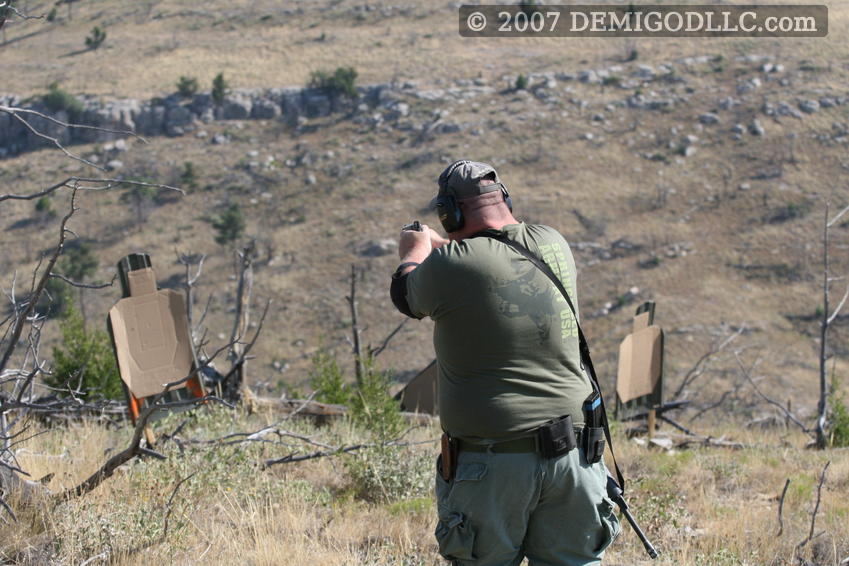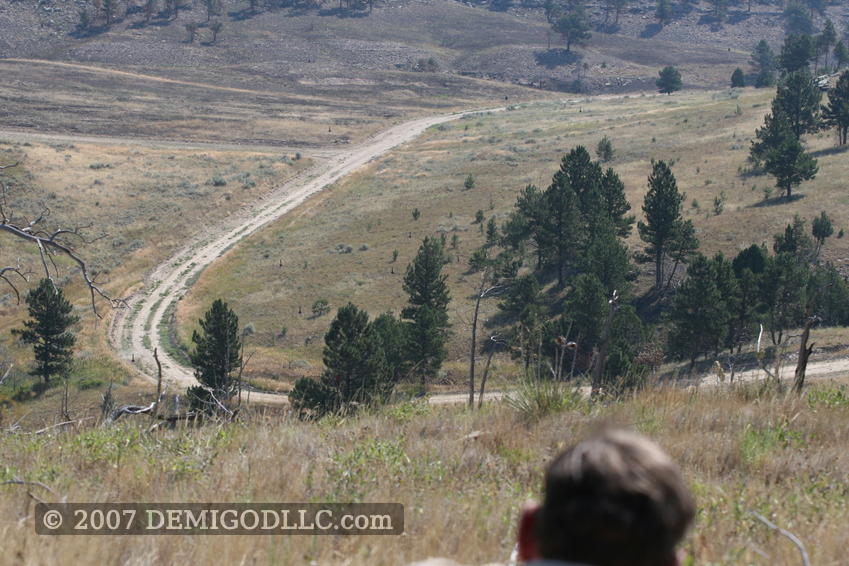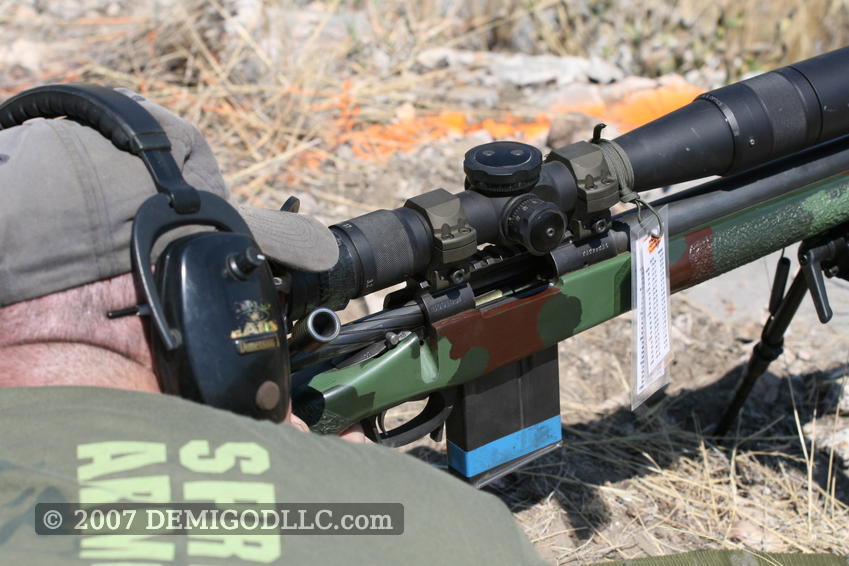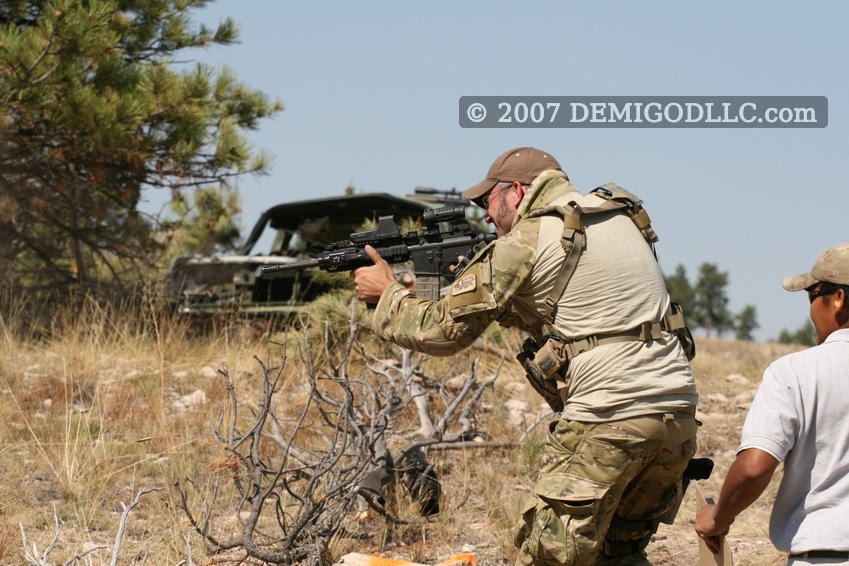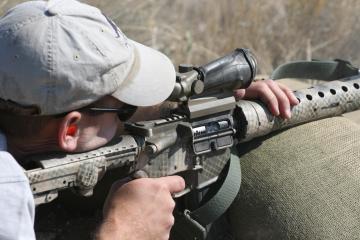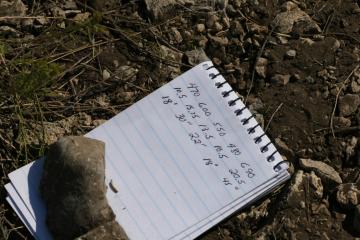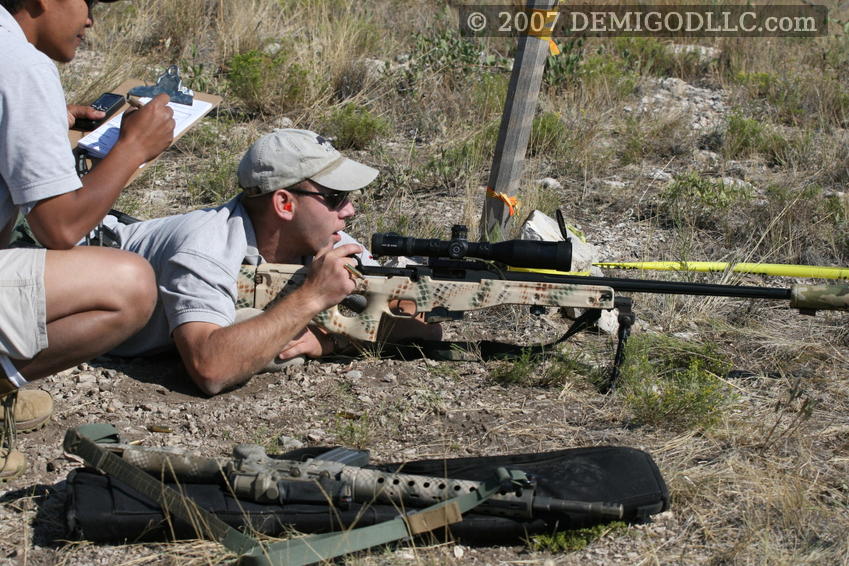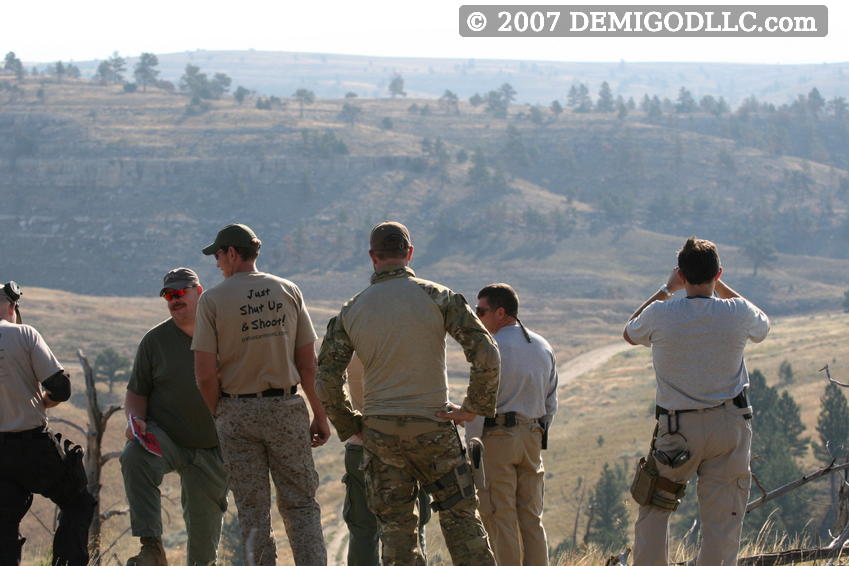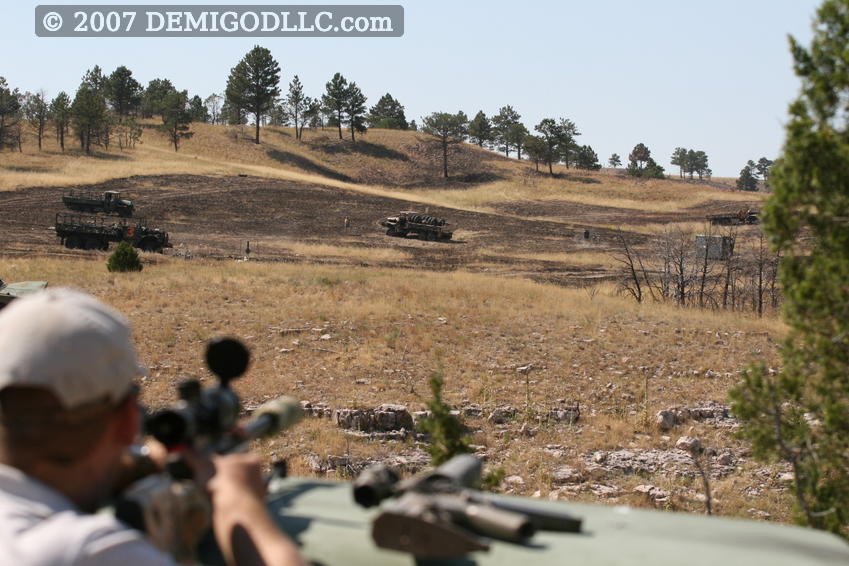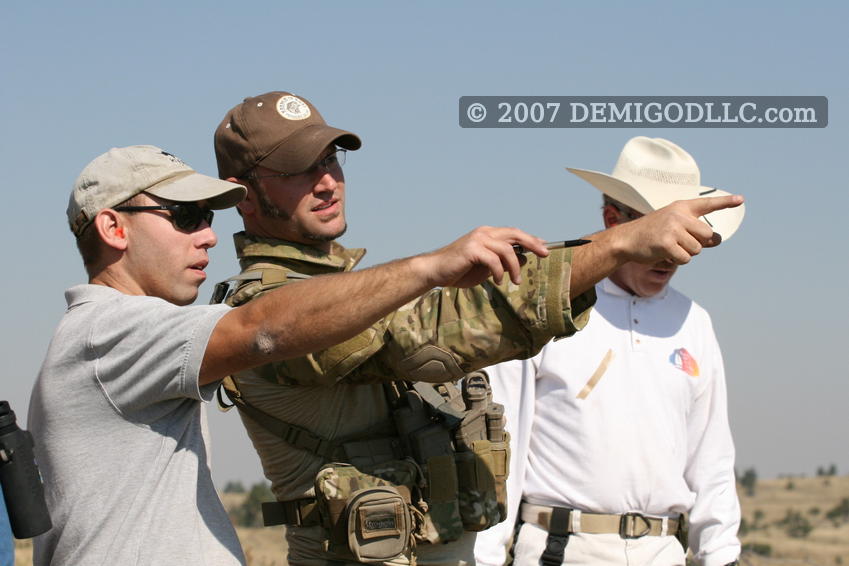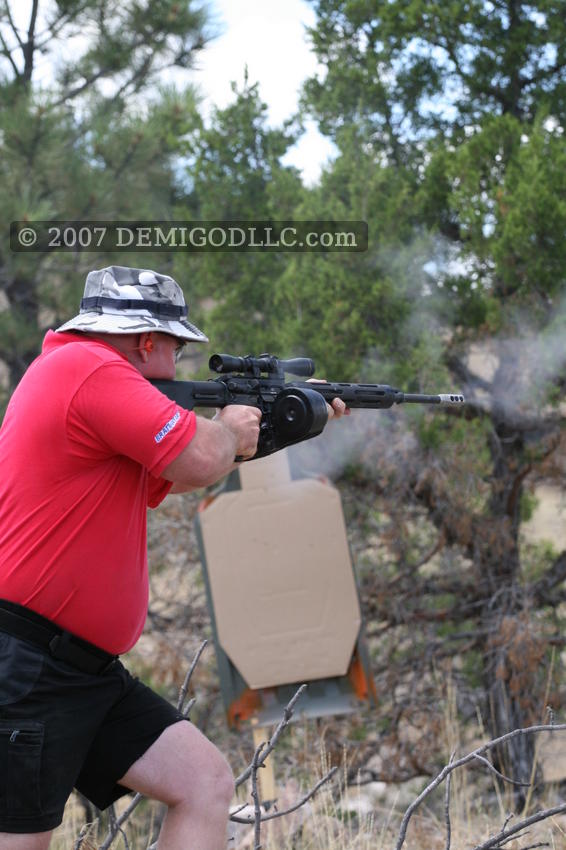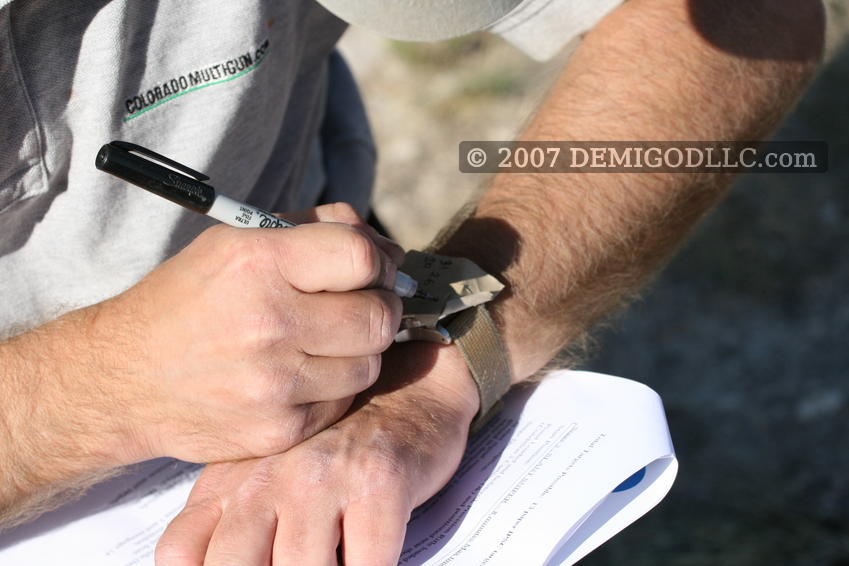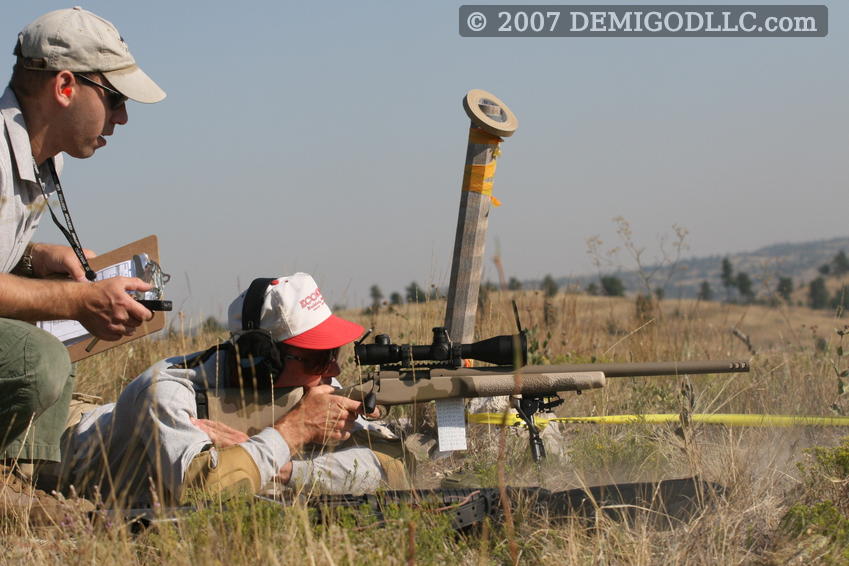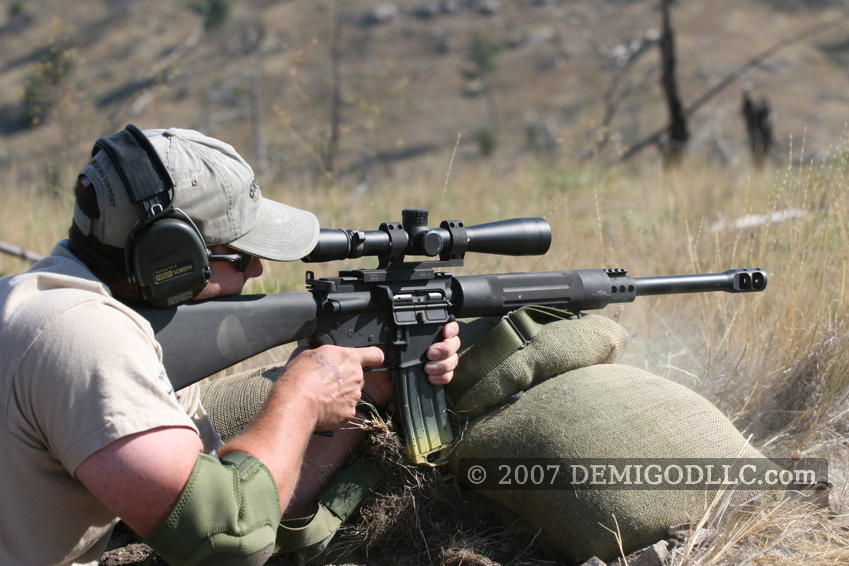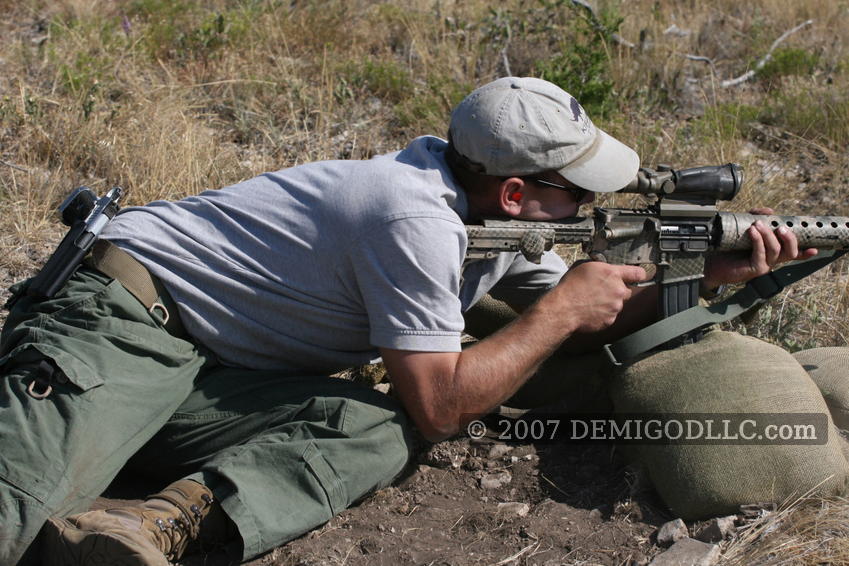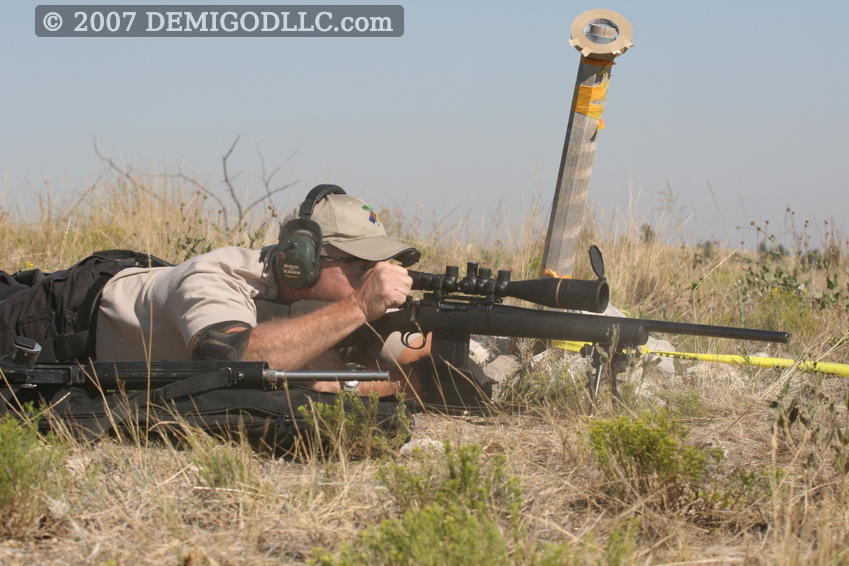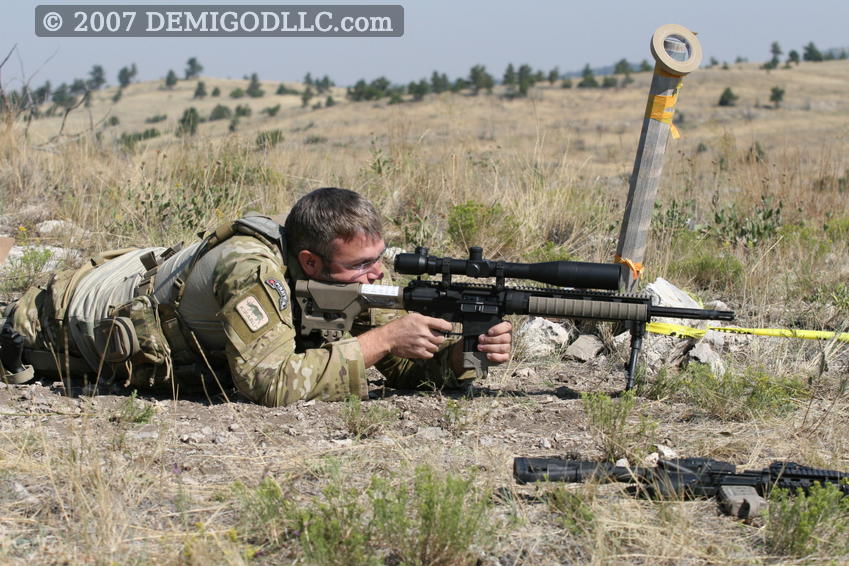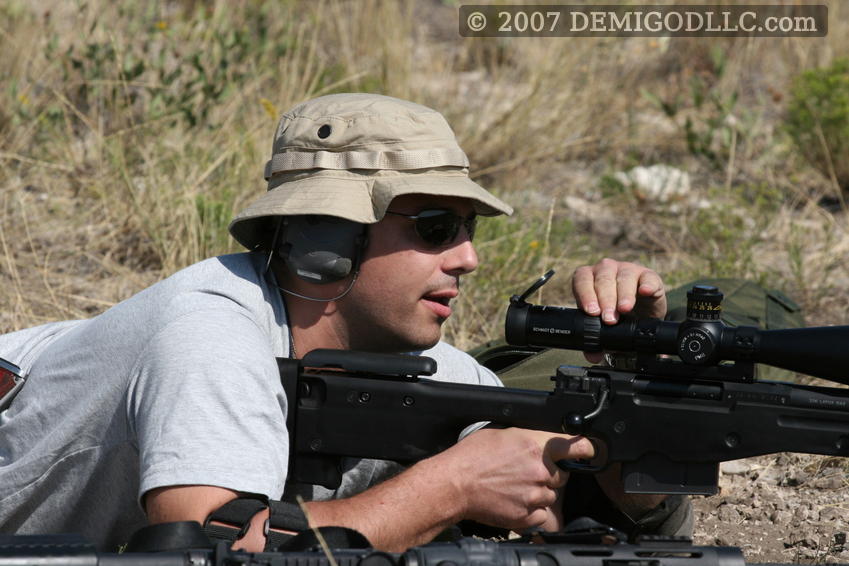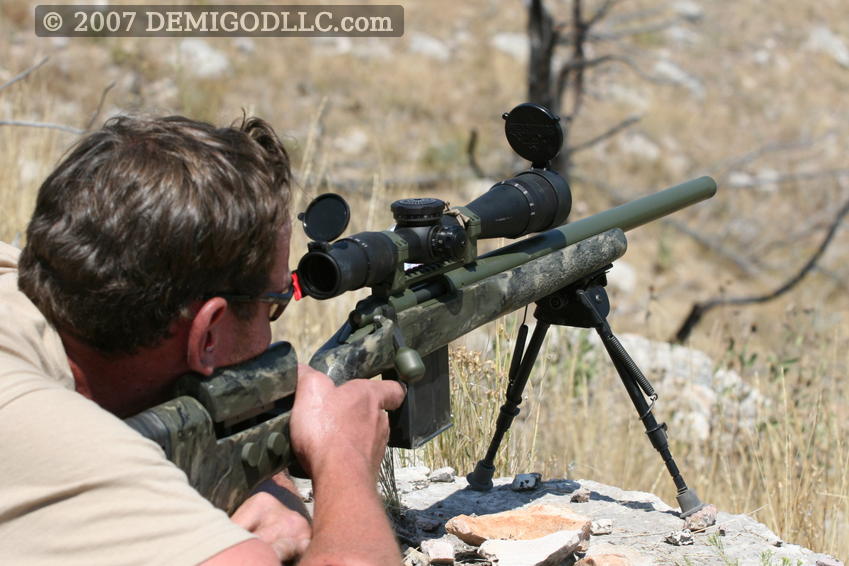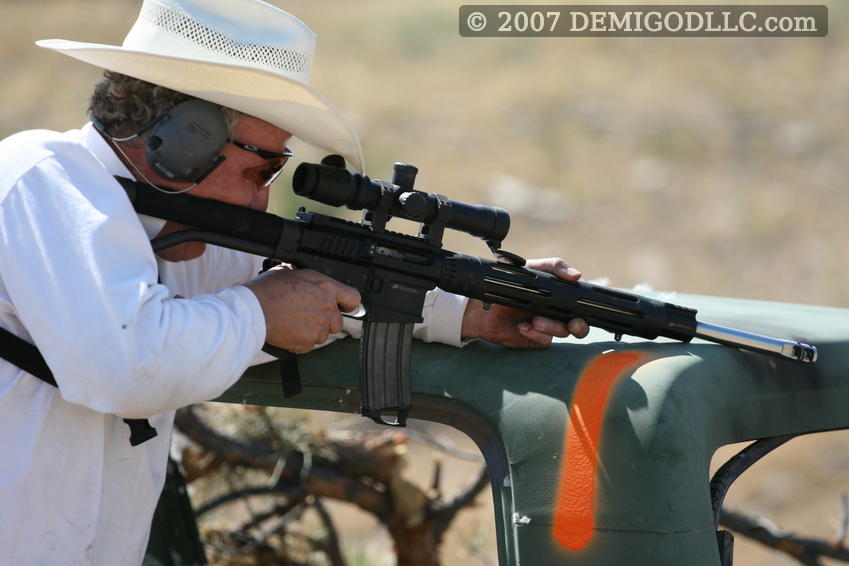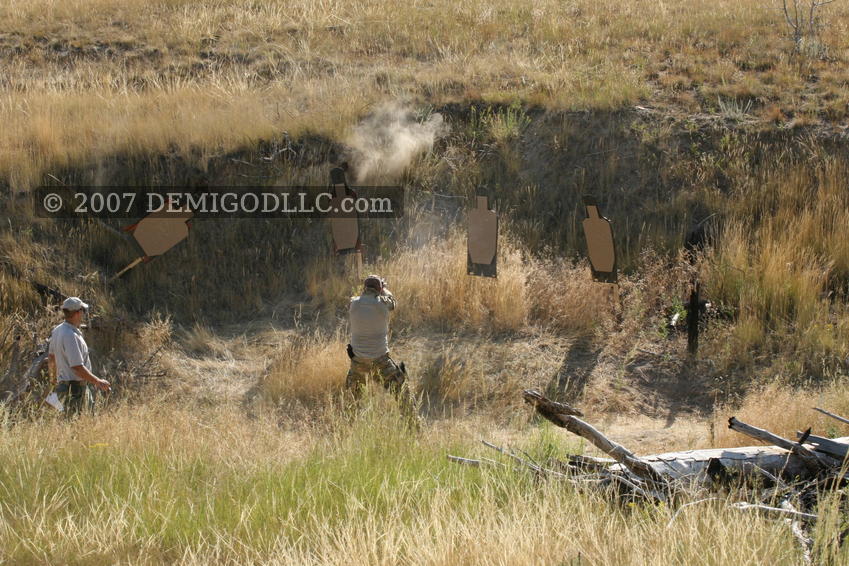In late 2005, five Rocky Mountain practical shooters started Colorado Multi-Gun as a vehicle to put on physical and technically-demanding practical multi-gun matches. With roots in the old Soldier of Fortune (SOF) and Rocky Mountain 3-Gun matches, and experience at various other non-standard field-style matches, the current trajectory should be no surprise. As one of the founding members of Colorado Multi-Gun, I am pleased to announce the successful completion of the 2007 Camp Guernsey Multi-Gun Invitational.
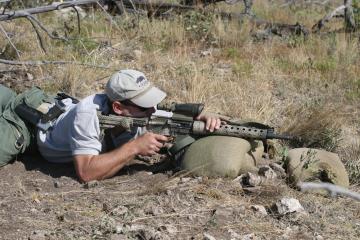

For those of you who are used to shooting on square ranges, or even a well-known field match such as Rocky Mountain 3-Gun in Raton NM, let me try give you a peak into the experience of shooting at the CGJTC. Pulling up to the main gate of the base, you are greeted by an armed guard and signs warning that all vehicles are subject to search and there is a 100% I.D. check. Your heart beats fast for a second when you realize that you have a bunch of guns and 1000 rounds of ammunition in the car; but it's okay, the guard knows you're here for the Colorado Multi-Gun event, so you proceed to the barracks and settle in. Travelling to the North shooting area where all but the night stage will be held takes about 30 minutes- ten minutes on a small highway with a "tracked vehicles only" dirt-trail next to it, and another twenty minutes on the dirt road that leads into the heart of the training area. You pass range guards and signs that warn "Warning: Military Property- No Trespassing," and you're reminded of the Unexploded Ordnance (UXO) briefing you heard the night before (and part 2). This place runs on big-boy rules.
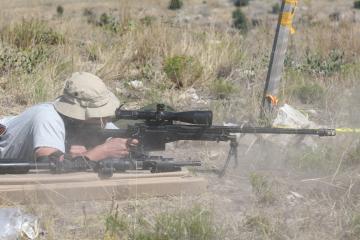
Shooters brought a variety of equipment for this match, however, some clear trends emerged. The most common pistol was a 9mm Glock or SV/STI. Almost everyone used an AR-15 of some sort for the carbine, with a low-magnification fixed or variable-power scope such as the Trijicon ACOG or TR21. Most shooters brought a bolt-action rifle for the long-range targets, with a variable-power tactical scope, chambered in .308, .260 Remington, or .300 Winchester. One shooter shot a .338 Lapua Magnum AI-AWSM, and several shooters used AR-10s chambered in .308. Laser range-finders were not needed, since long-range target distances were given in the match booklet. No ancillary equipment was allowed during the course of fire besides regular three-gun gear and a sole rear "beanbag" for the long-range rifle. With physical multi-gun stages, a secure holster and carbine sling were both required.
I shot my standard three-gun carbine and pistol. The carbine is an AR-15 with a "Comp-Tac" upper built by Paul Ertsgaard of MSTN, featuring a 17-inch Krieger barrel with a rifle-length gas system and PRI float tube, tipped with the MSTN "QC" Comp muzzle brake. It's topped with the Trijicon TA11 ACOG, a fixed 3.5x optic with a fiber-optic and tritium-illuminated reticle. The trigger is a JP "tactical" single-stage with the four-pound hammer spring, and the stock is a Magpul M93B. Since this match had some stringent accuracy requirements, I shot 75-grain Black Hills ammunition. For pistol, I shot my SV double-stack 9mm built by Benny Hill of Triangle Shooting Sports.
For the long-range precision rifle, I ran my Accuracy International AWP which has been fitted with a 25.3-inch Satern barrel chambered in 6.5x47 Lapua by George Gardner at GA Precision. The Invitational was the second match for the 6.5x47 Lapua AI-AW, and I knew it provided ballistics more or less similar to .260 Remington. Both of these short-action 6.5 mm calibers blow .308 Winchester out of the water and provide external ballistics that meet or beat factory 190-grain .300 Winchester Magnum loads.
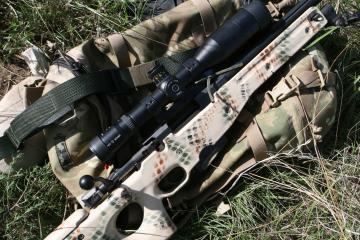
Scoring for this match was time plus penalties, with each stage contributing match points to the overall final results. Paper targets required one A-zone hit or two hits anywhere to neutralize. Hanging steel targets required one hit called by the RO to score, and dropping steel plates for pistol had to fall to score. Failures to neutralize for carbine or pistol incurred a 10-second penalty. Failure to engage (target not shot at at all) was 10 seconds. Competitors could shoot as much as they wanted to, to hit carbine and pistol targets, however, they could only shoot a maximum of two rounds at a long-range rifle target. A long-range rifle target missed on the first round but hit on the second incurred a five-second penalty, while an un-hit long-range rifle target incurred a 20-second penalty. For each stage, the shooter with the best score received 100 match points, and everyone else received a percentage based on the ratio of the scores.
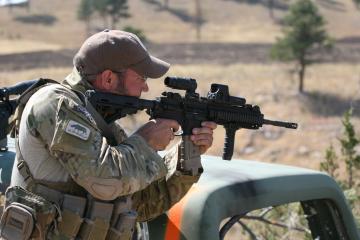
The match progressed with four full-on field stages on Saturday. Stage one was the held on the Mk19 Range, and was for carbine and rifle. The shooter started just back from the ledge of a drop-off, engaged five hanging steel plates down in a gully at a range of 60-80 yards, then range up along the ledge engaging six IPSC targets along the way at almost point-blank distance. Thirty yards away was an Army CUCV (Blazer), where the final six carbine plates in the valley were engaged. The carbine was grounded on top of the CUCV, and the long-range rifle was retrieved from the CUCV and three short-range rifle targets were engaged from about 150 to 250 yards. Eric Miller, an accomplished Three-Gun shooter and founding Colorado Multi-Gun member won this stage with 60.77 seconds.
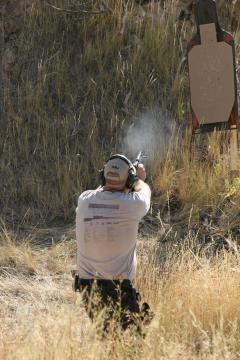
Stage three, Slant Sniper, was the first of the really tough rifle/carbine stages. As indicated, this stage took place on CGJTC's slant-sniper range, which has lots of distance and some steep incline available. The shooter started within arms' reach of the starting post, aimed in with his long-range rifle at one of the five rifle plates spread from 470 to 690 yards. After engaging these five rifle targets, he retrieved his carbine, slung it, and ran 30 yards down a path engaging five IPSC paper targets and four steel plates with his pistol. At the final position, there were seven hanging steel plates for carbine spread from about 250 to 330 yards away, at the base of the hill. This course of fire was challenging due to the steep downward angle of the carbine shots, and the very small size of the carbine plates- some were only three by five inches. Although the long-range targets were tricky due to wind conditions, the carbine shooting was what ate up time for many shooters on this stage. IPSC Champion Henning Walgren won it with a time of 143.77 seconds and incurring an additional 50 seconds in penalties. Nobody shot the Slant Sniper stage without being penalized for some misses.
The last stage of Saturday was stage four, Sniper One. Shooters on Sniper One started by engaging three long-range rifle targets at 465, 500, and 615 yards, then running about 50 yards down a rocky hill carrying both rifle and carbine to the second shoot position. From here, they re-engaged the three rifle targets, then transitioned to the carbine. There were fourteen steel carbine targets spread out in the valley down-below approximately 50-150 yards away, some large, and some very small. With those targets engaged, the shooter ran another 50 yards down the ridge to re-engage the same fourteen targets again from a different perspective. Again, carbine shooting proved to be the way to "lose" this stage. Keeping track of which targets had been engaged while having trouble hitting the smaller targets was confusing to many. I won this stage by shooting it clean (no misses or penalties) in 212.92 seconds.
Sunday's stages were simpler, but still not something you can shoot at a regular three-gun match. The first was the CPQC, a close-range course utilizing military pop-up targets. Starting 25 yards back, the shooter engaged pop-up targets as they appeared for 40 target presentations. After that string, he proceeded forward to the 15-yard line. From here, he engaged another 40 pop-up targets as they appeared with only ten rounds of carbine, transitioning to his pistol for the remaining 30 engagements. Finally, at the zero-yard line, he engaged all 40 pop-up presentations with his pistol only. This was the first time the CGJTC's CPQC range was used for training or competition and some bugs were evident in the scoring computer, however, Mike Dowd won this stage with 102 hits.
The last stage was the Convoy, where shooters engaged 23 possible pop-up targets along the military convoy training course while riding in the back of a HWMMV driving at 20 mph. This stage demonstrated just how difficult it is to hit targets at 60-200 yards while moving at what most consider to be a slow speed. The average competitor shot about 90 rounds during this 50-second run. John Sternberg and Trapr Swonson both had seven hits on this stage, tying for the stage win.
This was quite simply a very hard multi-gun match. The two "sniper" stages had time limits of eight minutes each-- that's 480 seconds of shooting. Sniper One saw about half the shooters time out while still engaging the 28 carbine targets. The match had enough hard shots with each weapon that shooters had ample opportunity to tank a stage by wasting way too much time on a couple difficult targets. With a station altitude of over 4500 feet and daily temperatures around 100 degrees, being physically fit and able to keep focus all day was key.
Throwing together a carbine or rifle a few days before the match almost assures difficulties or failure at a match of this type. There is a level of organization and experience required to make first-round long-range hits with a precision rifle. Even with the carbine, a solid zero and knowledge of trajectory is required to hit small targets at 100-300 yards.
Since ranges were known, most shooters made a "cheat-sheet" of dope values to dial for the long-range rifle targets, to consult while transitioning target to target. Another strategy is to shoot targets in an order to minimize elevation dial adjustments, or to dial to an intermediate target's elevation and then use the reticle to hold over and under for the closer and further targets on the stage. To simplify my sight picture, I dialed the dope values for every long-range target (except on Mk19), and concentrated on using the reticle for windage hold-off.
As one of Colorado Multi-Gun's major matches of 2007, we put together a pretty good prize table including: two rifles courtesy of Sabre Defense; a couple AccuPoint scopes from Trijicon; thousands of dollars off on Sierra bullets; a bunch of Magpul gear; a complete piston-operated AR-15 upper from POF; and two sets of body armor from Point Blank for the high LEO and Military shooters; many $150 certificates from Cavalry Arms. Cavalry Arms also donated an excellent set of EMT medical gear.
In 2006, Colorado Multi-Gun ran the PRTC; in 2007, we took advantage of a new opportunity and ran the Invitational instead. What will 2008 bring? It's too early to tell just now, but you can bet it'll involve some hard practical shooting in a fantastic field setting. Hope to see you out there!
RESULTS
STAGE POINTS ....................................... TOTAL
1 SMITH, ZAK 95.72 74.85 98.80 100.00 87.25 57.14 84.38 598.14
2 SWONSON, TRAPR 71.91 70.16 88.22 39.70 82.35 100.00 90.63 542.96
3 WALGREN, HENNING 61.18 73.99 100.00 65.84 97.06 57.14 81.25 536.46
4 SAMUEL, ALAN 90.03 77.30 62.25 45.46 90.20 71.43 96.88 533.54
5 DOWD, MIKE 51.34 66.13 70.57 50.25 100.00 71.43 96.88 506.59
6 CASANOVA, ADAM 66.00 68.29 81.40 54.98 90.20 85.71 59.38 505.96
7 ALLISON, MARK 66.05 46.83 59.43 48.90 85.29 57.14 87.50 451.14
8 MILLER, ERIC 100.00 93.59 86.40 2.18 94.12 0.00 62.50 438.79
9 BRANDT, DAVID 63.25 56.46 60.85 44.69 84.31 71.43 50.00 431.00
10 EARNEST, DANIEL 59.80 77.02 84.36 45.79 88.24 14.29 56.25 425.74
11 DELENA, GEORGE 69.87 50.43 60.48 26.58 89.22 42.86 84.38 423.80
12 KOLAR, MIKE 51.68 47.48 75.37 33.79 85.29 57.14 71.88 422.63
13 WARD, CHUCK 45.56 25.24 55.37 39.99 80.39 71.43 100.00 417.98
14 STERNBERG, JOHN 64.65 42.96 51.27 38.23 85.29 100.00 34.38 416.78
15 FIELD, MICHAEL 34.57 75.58 43.63 43.14 88.24 28.57 96.88 410.60
16 OCHS, STEVE 54.44 48.27 68.37 25.92 84.31 42.86 81.25 405.42
17 CURLETT, MIKE 53.73 50.53 41.18 30.91 89.22 42.86 90.63 399.05
18 RHODES, EDDIE 53.25 100.00 46.89 36.99 93.14 14.29 53.13 397.68
19 MOWERY, GARY 44.71 65.22 85.21 53.12 85.29 0.00 62.50 396.06
20 MOSIER, DAVE 76.28 57.13 38.11 30.66 91.18 28.57 68.75 390.68
21 TSIKOUDAKIS, ARI 39.69 46.94 67.84 35.59 96.08 57.14 43.75 387.02
22 CASANOVA, JAMES 51.17 79.10 64.22 25.94 87.25 14.29 59.38 381.36
23 CLARK, DRAKE 45.58 36.81 40.37 24.91 82.35 71.43 68.75 370.19
24 O'NEILL, JAMES 44.42 36.60 86.52 38.04 75.49 14.29 71.88 367.23
25 CUMMINGS, HUNTER 41.20 28.29 38.50 35.43 79.41 28.57 87.50 338.90
26 BLAND, MICK 51.41 34.91 35.23 32.77 86.27 14.29 68.75 323.63
27 WRAY, JOHN 31.92 21.64 69.42 25.94 71.57 42.86 53.13 316.47
28 MORGAN, GRANT 45.30 42.30 41.15 29.45 89.22 28.57 37.50 313.49
29 STURM, STEVEN 40.92 48.80 36.22 28.12 82.35 42.86 9.38 288.65
30 PETRIE, CHRIS 27.01 36.17 39.33 25.64 69.61 42.86 18.75 259.36
31 WERTH, DEREK 43.41 28.15 31.77 23.56 71.57 57.14 3.13 258.72
32 McCUMBERS, CHAD 34.36 41.99 38.36 24.75 85.29 28.57 3.13 256.46
33 NEALON, SHAWN 34.26 38.73 61.79 29.85 86.27 0.00 3.13 254.04
34 FANKHAUSER, LISA 20.63 39.41 39.15 27.07 71.57 28.57 18.75 245.14
35 NOON, SHAWN 24.98 32.21 32.03 23.16 61.76 57.14 6.25 237.54
36 CARLTON, VICKI 22.51 38.80 35.81 2.18 78.43 14.29 40.63 232.64
37 CARRUTHERS, CHUCK 40.31 56.76 33.70 33.27 0.00 0.00 65.63 229.66
38 JUAREZ, JUSTIN 37.52 30.74 43.02 25.05 0.00 0.00 9.38 145.71
OTHER RESOURCES
FULL MATCH RESULTS
Henning Walgren's Match Report
Rest of DEMIGOD LLC's Invitational photos
MORE PHOTOS
